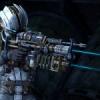The similarities between the Metroid series and Alien are well documented, saving us the trouble of having to go over them all here. Arguably the most enduring element that Metroid inherited from Alien’s legacy isn’t so much a feature, but a vibe; the fear that comes from being isolated in a fight against the unseen and unknown. The Metroid games don’t strictly belong to the survival horror genre, but the palpable sense of dread one experiences whilst navigating the labyrinthine game worlds is survival horror distilled and purified.
Much like any good survival horror, the thickest tension is built up not from the saturation of jump scares, but the understated eerie sense that something is ever so slightly…off; you’ll enter a room you’ve traipsed through a dozen times before, only to find the usual background music has cut out - the sound of your footsteps echoing ominously.
It’s interesting to reflect that the stress of uncertainty is such a big part of the design in a series that conversely - even contradictorily - hands out detailed area-wide maps. But even this is a calculated design choice; sure, the cryptographic aides serve as a navigation tool, but they also instil an ill-gotten sense of confidence in the player, leading them to believe that they know their surroundings.
The danger of the unknown, even (or perhaps, especially) the unknown the player feels they know, and the tangible, almost quantifiable sense of dread works so well in the Metroid games because the solitary player has no one to turn to for help; not even their avatar – stoic bounty hunter Samus Aran – has any words of advice for them. Indeed, modern players jumping into the series for the first time might be bewildered by the lack of a disembodied voice on a God mic.
At least all this was true of the series until the release of Metroid: Fusion. Metroid: Fusion for the Game Boy Advance and Metroid Prime for the Gamecube were released side-by-side in 2002. Fans who wanted to be sure that they were getting the unadulterated, solitary open-exploration the series was known placed their faith in Fusion as the 2D Fusion seemed far more reminiscent of the classic 2D Metroid games than Prime did by far.
But looks can be deceiving: It was Prime that stuck to the format and structure of the series, whereas Fusion deviated from it. Fusion had a developing narrative rather than a simple premise that took a backseat to open exploration. Reams (by Metroid standards) of monologue from Samus herself threatened to shatter her image as a mystery-shrouded solitary heroine on an alien world. In fact, in Fusion Samus was neither solitary nor on an alien world; she was in close contact with a mysterious AI C.O. and events played out on an abandoned Biologic Space Laboratories (BMS) Space Station.
Samus finds the station overrun with parasitic organisms capable of assimilating anything they attack. Known as “X” these parasites’ numbers were kept in check by the once flourishing Metroids. Having been around for the death of the last Metroid, Samus knows full well that if the X were to ever escape the station (without the Metroids’ counteractive influence) the results could be disastrous.
The vague naming of “X” gives the parasites a sense of opaqueness and mystery. It’s a subtle reminder that although Fusion is different from its predecessors, it’s still playing on the our primal fear of the unknown.
This seems at odds with the unfamiliar familiarity of the computer C.O, which series veterans may feel is thrust upon them. Samus even names the computer “Adam” after a previous C.O of hers; the familiar name perhaps designed to contrast the vague “X”, maybe even an attempt to cajole the player into developing a sense of camaraderie with their AI companion. Whatever the case, we don’t learn much about Adam and Samus’ history other than that they had a mutual respect for one another (and possibly more) and that Adam would refer to Samus in good humor as “Lady”.
Fans may have been understandably upset by the AI’s inclusion. It threatens to impinge on the sense of isolation amongst the unfamiliar that had become a series staple. But Fusion uses the AI to create a complementary emotional response in players that is exceedingly rare in videogames – paranoia.
It seems that whenever Samus takes orders from her AI C.O she ends up in a perilous situation; a room where the doors lock behind her, an elevator where the power fails, or a cryogenic chamber that seems to be haunted. It’s amazing that the sensors of a seemingly all-knowing computer repeatedly fail to give Samus any heads-up of the danger it marches her into. And behind Samus’ back we see glimpses of conspiratorial conversation between the AI and a third party. In one section, Samus clambers her way out of hell right back to the AI’s terminal - something the AI seems surprised at, betraying the slightest hint of disappointment that Samus is still alive.
In contrast to other Metroid games - which flirted exclusively with fear of the unknown - Fusion wantonly toys with the fear of the known, as well as the unknown. You’re asked if you’d rather the devil you know (the AI) than the one you don’t. And it isn’t an easy choice when the devil you don’t know is the SA-X; a powerful X parasite that has Samus’ shape and abilities – get spotted and you’ll be chased down with poor odds for survival.
This process happens gradually over the 8-10 hour playtime. During which, the player builds an increasing distrust of the AI companion that initially seemed positioned to comfort or baby series newbies. The quintessential Metroid essence of isolation that looked to be threatened by the AI’s inclusion was conversely heightened. The player felt isolated precisely because the only place they could turn to for help was suspect.
In the climax of the game, Samus is horrified to learn that the Galactic Federation, far from wanting to eradicate the X, want to recapture them for research – putting the galaxy at potential risk. Samus’ trust in the Federation is shaken - yet another thing she can’t trust.
The AI, with the entire space station at its disposal, locks Samus in to prevent her from enacting a purge of the X. Samus finds that all the plasma beams and power bombs in the world can’t get her out of a this one and so she implores the AI to do something, anything: “Don’t let them [the Federation] do this. Can’t you see what will happen, Adam?” addressing the AI directly for the first time as “Adam”. Puzzled, the AI asks her who this Adam is, and what he would do in this situation.
Samus recounts that Adam had sacrificed himself for her. The details are not divulged, but they aren’t important. What matters is the debt of gratitude Samus feels towards her former C.O. She still owes him one.
What happens next is a masterstroke of showing without telling. The AI callously rejects Samus’s plan to blow-up the BMS Station as absurd and unworkable. Then, in an uncharacteristically co-operative gesture, it suggests another plan - eliminating the X by throwing the station into nearby planet SR388’s orbit. This was one of the first times in series history that an emotion clearly played across Samus’s face. Her eyes open in shock as she comprehends the AI’s complicity in betraying the Federation and abetting her. The AI gives one last farewell to Samus after briefing her: “That’s an order. Any objections, Lady?”.
In that moment the implication of the AI “Adam’s” words - that he is the real Adam - races through players’ minds. The cocky but respectful “Lady” is something the player knows to have been Adam’s pet phrase. So you accept that this AI must be the real Adam without condition or protest – an impressive feat of suspension of disbelief, as it isn’t explained until later how Adam could even still be alive.
Up until this point, Fusion tortures players with isolation and paranoia. The game starts with a bleak premise and the situation gradually devolves, pushing Samus into hopeless despair. And then there’s the moment when Samus is offered respite in the form of jubilant camaraderie between her and “Adam” – an emotion that would normally be jarringly at odds with the Metroid experience. But it’s a powerful moment precisely because Fusion took the time to create contrast by starving players of anything they could trust in.
So powerful is this one moment that it left fans aching to delve into Samus and Adam’s history, which in turn spurred Nintendo to pen Metroid: Other M. Although critical reception towards that origin story was less than favorable, anyone who plays Metroid Fusion today will come away wanting to know more about Samus and Adam’s relationship. Nintendo’s games are seldom plot-heavy or explore dark themes such as the experience of fear and paranoia in quite the way Metroid Fusion does, and that’s a shame because Nintendo can handle those elements maturely when it tries.








